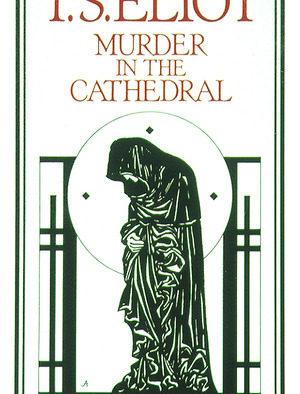MARTYRDOM in MURDER IN THE CATHEDRAL

T.S. Eliot
Thomas Stearns Eliot was perhaps one of the most highly-acclaimed literary figures of the modernism movement. He (1888-1965) was an American-born, English-adopted poet, playwright, and literary critic. His career took a turn for the better after he published The Love Song of J. Alfred Prufrock. His poems were typically centered on the disappointment and emptiness of World War I. He was awarded the Nobel prize in Literature for his contributions to poetry. Eliot also penned some very successful dramas i.e. The Cocktail party, Murder in the Cathedral, Cats, The Rock, etc.
Murder in the Cathedral
His most successful verse drama is Murder in the Cathedral. It was first displayed in 1935 during the yearly Canterbury Festival. The title and content of the play refer to the martyrdom of Saint Thomas Becket. He and King Henry II were intimate friends but when Becket was appointed Archbishop of Canterbury, he started rebelling against the King’s authority and power. This put a strain on their friendship and cordial ties. Becket fled to France for seven years and returned to England to embrace his fate. The play begins with Becket’s return to England and ends with his life sacrificed in the name of God.
Central theme of Martyrdom
The central theme of Murder in the Cathedral is martyrdom. Martyrdom means the act of suffering and death of a martyr. A martyr is someone who has sacrificed their life for the cause of God and Jesus. In the Bible, there are many stories of martyrs being physically and emotionally tortured (various ways include stoning, burning, crucifixion, etc.) by others but tolerating it for a higher, spiritual cause. The title of the play hints that it deals with martyrdom and it actively invites the readers to participate in the act by watching it through the eyes of the chorus.
Conventions Utilized
There are various conventions that Eliot has made use of to reinforce the theme of martyrdom in the play. These include Chorus, representations of vices (via tempters), and the prose interlude that separates both poetic parts of the play. These work together to infuse the idea of Christian martyrdom into the audience.
The first convention is the Chorus. Eliot borrowed this constituent from Greek tragedies but also reinvented to suit his purpose. Eliot’s Chorus serves a few functions such as mediating the action between the audience and the characters and commenting on the witnessed events. However, the main aim of Eliot in utilizing Chorus is to bridge the gap between saints and ordinary men. Since commoners would not be able to understand the actions of a Man of God, the Chorus helps them to understand it better. A critic noticed that “Christian life is often called an imitation of Christ”. Therefore, the Chorus displays the journey towards salvation.
At the beginning of the play, they are fearful. Although they know that they are not in any danger but there is a pre-agreed premonition that something bad is going to occur in the cathedral. The Chorus says “only to wait and to witness”. Here, witness is used in the Christian sense. This means that even though they are not actively doing anything, they are still involved in the upcoming events (Thomas’s death). Later, the Chorus pleads to Becket to leave before he can be killed by the knights. They are afraid that without him, they will lose their spiritual leader.
After Becket is killed, they mourn his life with words like “defiled with blood”. As commoners, we would react in the same way. We do not see the higher cause that Thomas gave up his life for. But, at the end of the play, when the Priests rejoice that they have a new martyr, we understand that martyrdom is needed to keep the world pure and to encourage others to pursue God’s way. The whole cycle of fear, regret and faith mirrors the feelings of the audience. According to a scholar, “By reflecting the emotions of the audience, the chorus invites the audience to become one with them”.
Conventions Utilized Cont.
The second convention that is employed are the four tempters. These are the representations of vices and this aspect has been adopted from Medieval Miracle and Morality Plays. The fourth tempter is the most significant one as he is unexpected but also the best representation of Thomas’s inner conflict.
ALSO READ: MEDIA and its INFLUENCE
This episode with the tempters is quite similar to the Biblical story of Christ’s temptations. Eliot shows Thomas’s internal struggle out on the stage and the dialogues between him and the tempters confidently assert his ambiguities, doubts and insecurities. A critic noted that these tempters aid “in the development of the plot”.
As mentioned before, the fourth tempter is unexpected because Thomas did not even suspect that he had these ideas in his subconscious. He seduces Thomas with “eternal glory” in the future. He represents Thomas’s ideas of martyrdom for the wrong reasons—not for God but for self-glorification and remembrance. This is the greatest temptation that Becket must face as if he gets lured in, he will commit one of the greatest sins—pride. Thomas, however, manages to overcome it and accept his fate willingly. Instead of embracing martyrdom actively, he will face it passively.
The last convention is the interlude. In this part of the play, Becket delivers a sermon to the audience.
This sermon, delivered in prose, is again meant to reinforce the theme of martyrdom. He preaches celebration of birth and death of Christ and how it is the same with martyrs as well. An important word “peace” is used by Becket. Any layman might think that he is referring to world peace or inner peace. But, this peace signifies a much higher and grander concept. He goes on to discuss martyrdom.
He says that “Saints are not made by accidents” but for a much greater spiritual cause. He also mentions that worldly gains and ambition has no place in heaven. He tells the audience that martyrs who die because of ambition or some other worldly benefit will not achieve true martyrdom. Only the one who “has lost his will in the will of God” and “found freedom in his submission to God” will achieve the highest honors that martyrdom offers.Therefore, he foreshadows his own martyrdom.
Conclusion
Therefore, by the use of the Chorus, Tempters, and Interlude, Eliot reinforces the theme of martyrdom throughout the play. Murder in the cathedral is a historical play but it much more than that. It is a religious verse drama that focuses on the need and significance of martyrdom. The Chorus introduces the concept, the tempters develop it and the interlude gives another note on it. The final dialogue between the Chorus and the priests conclude on the subject of martyrdom.
Currently, I am a student of Fatima Jinnah Women University. With a burning passion for psychology, words, and dreams, I decided to abandon medical studies for humanities. These days, when I’m not listening to ballads, watching movies, or sitting down with a good novel, I am rigorously studying Hangul (Korean language) to satisfy my obsession for BTS and K dramas. I’m a thinking introvert and INFJ personality. Therefore, I like ‘me time’. My articles typically resonate with psychological well-being advice.








